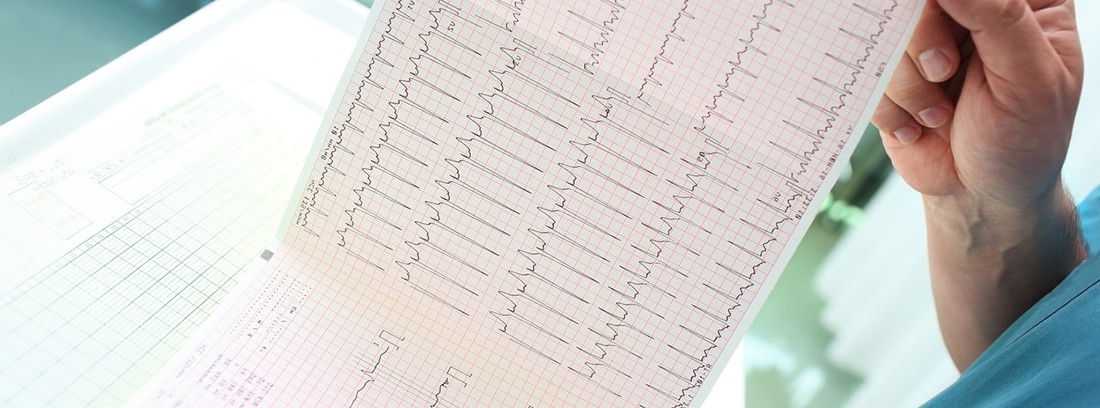Wolf-Parkinson-White syndrome (SWPW)

Wolff Parkinson White syndrome is an abnormality in the conduction of the electrical impulses from the heart due to the presence of an accessory conduction pathway between the atrium and ventricle, that is, another alternative pathway. This can lead to episodes of (elevated heart rate).
It can appear at any age and in it a series of alterations are registered that make us suspect it.
How is it produced?
Under normal conditions, the heart contracts rhythmically and synchronously. This contraction is the result of an electrical impulse that is generated in the atrium and reaches the ventricle following an established circuit and results in a heartbeat.
In Wolff-Parkinson-White (WPW) syndrome in the heart there are some additional conduction paths between the atria and ventricles. Due to this accessory conduction pathway, electrical signals reach the ventricles earlier than they should (known as pre-excitation), activating in advance because the impulse does not follow the normal circuit. The result is a very high heart rate, and the presence of these abnormal circuits between the atrium and ventricle puts these patients at higher risk for tachyarrhythmias (rapid arrhythmias).
In most cases, this accessory conduction pathway has a congenital origin, that is, it is present from birth. It can also appear associated with the presence of heart malformations or other heart diseases.
Symptoms
Some patients do not have any symptoms and it is discovered by chance when performing an EKG.
Many patients may experience episodes of tachycardia with palpitations usually of sudden onset and end, dizziness, fainting, chest pain, or shortness of breath. The frequency of tachycardia episodes can be highly variable.
Only a small percentage of patients may be at risk of sudden death from serious arrhythmias.
Diagnosis
The diagnosis is based on changes in the tracing of the electrocardiogram that makes us suspect the existence of this accessory pathway.
Other complementary tests that are usually performed include:
- Chest X-ray and Echocardiogram, which show if there are alterations of the heart.
- Analytics: they can help to establish the causes that trigger the arrhythmia.
- Electrophysiological study. It allows obtaining a map of the electrical conduction system of the heart by introducing a series of cables, to find out the type of arrhythmia and its possible origin. It is indicated in those patients with symptoms and prior to performing ablation treatment. By conducting this study, the accessory or anomalous pathway responsible for the syndrome that can be destroyed by radiofrequency is identified.
Treatment
There are 2 main treatment options: drugs or ablation. The indication for each of the treatments must be individualized based on the risks and symptoms of each patient.
Asymptomatic patients without episodes of tachycardia generally do not need treatment.
- Pharmacotherapy. Patients with tachycardias may require antiarrhythmic drugs. They act by delaying the stimulus that reaches the ventricle prematurely and causing it to follow the normal conduction circuit, thereby preventing the appearance of tachyarrhythmias. Pharmacological treatment can be useful in those patients in whom ablation cannot be performed or when it fails.
- Catheter ablation. Catheter ablation is the treatment of choice in patients with symptoms. It consists of locating the accessory pathway by performing an electrophysiological study. Once located, it is selectively destroyed by the application of radio frequency. This treatment can be curative in up to 90% of cases, although it is not without complications. On the other hand, the accessory pathway may reappear and require the patient treatment again. It can be done in children and adults. It is especially indicated in those patients at risk of sudden death. <
- Surgical ablation. Surgical ablation is used much less than radiofrequency ablation. Selected cases may be recommended in which radiofrequency ablation fails or when the patient requires cardiac surgery for other reasons.
Prevention
This syndrome cannot be prevented since in many cases is congenital, that is, from birth. When it is detected, it is recommended to perform an electrocardiogram on the siblings to rule out other affected relatives. Patients with Wolff Parkinson White syndrome can lead a normal life but it is advisable to avoid competitive sports as they can promote tachyarrhythmias.
(Updated at Apr 14 / 2024)